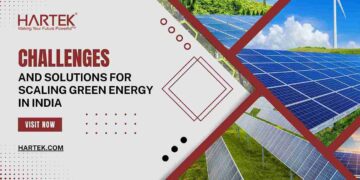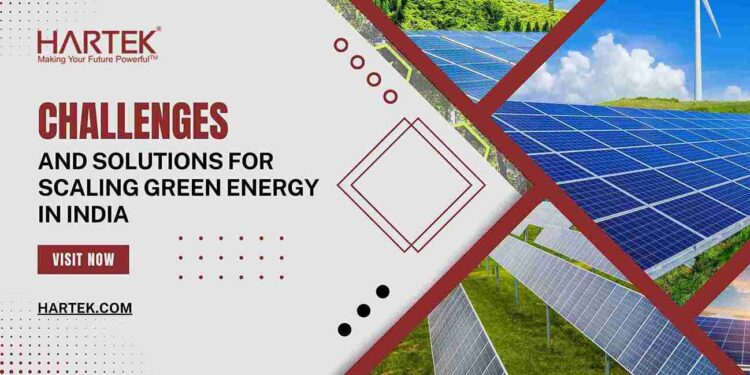India is among the leading countries with an immense growth rate within the contemporary global economy. But it has energy issues owning to steadily growing energy consumption and strong reliance on fossil energy sources. This dependence alters energy security and, at the same time, is highly destructive to the environment. For these problems, India is planning to increase its generation of renewable energy especially the solar and wind energy. But passage to a large scale of green energy also poses its own set of problems. This blog briefs about few significant issues associatively linking to the scale up of green energy in India and about the possible solutions for those issues.
Here are some Key Challenges and Solutions for Green Energy India
Challenge of Land Availability
One major factor influencing the siting of massive plants of green energy like solar and wind energy in India is the availability of land. It becomes a big challenge to secure unused land for the development of renewable energy projects for several factors. Agricultural and forest use for energy production has other economic and environmental uses in crop and timber production in the country. Siting of power projects also attracts opposition by the locals on issues arising out of either common land usage or land acquisition for private use. Even though rooftop and distributed solar effectively nudges this challenge to some degree, the availability of land for utility scale green power plant is restricted in Indian context.
Solutions:
Utilize either very low or severely underutilized land for rene- wable power projects where the opportunity cost is very low. State governments can, therefore, look for and purchase such lands to be let out to project developers. The social affectations and the consultation procedure about the land acquisition need to be carried out earnestly. Such practices as afforestation and the grazing of animals can be integrated into the same piece of land that is used for renewable energy production and this will also assist in attaining locals’ acceptance.
Challenge of Grid Integration
While integrating higher quantities of intermittent renewable energy in India and distributed resources to India’s electricity grid is convenient, quite complex is the fact that various green power sources posses certain intermittency. Problems such as the variability of renewables like the sun and wind, small levels of interruptible or peaking generation, load following, storage, and transmission define the extent of cost-effective and reliable renewable generation that the grid can achieve. Achieving a 24×7 renewable energy supply at the utility scale calls for substantial grid modernisation and market reforms in India.
Solutions:
For effective integration of RE generation with the grid, India requires features such as forecasting systems, DR progams, DER, hybrid integration of RE sources, upgrading the transmission network, and real-time markets. Support for pilot projects including VPPs and REG states is also needed to better learn more effective set of renewables integration into the grid and to lessen the stress and cost that result from the integration of high shares of renewables.
Challenge of Financing Large Projects
Large financial sources that are needed for putting up utility scale green power projects in India are hard to come by and cannot solely be sourced from private contractors. As well as, the capital costs that are taken by renewable energy technologies are relatively higher than the costs incurred by the fossil fuel plants to which renewable energy projects are most of the time compared with and so this makes projects risky for financing. Banks and investors’ internal fund constraints, perceived technological hazards, credit performance of new projects untraceable, and long gestation periods act as financial constraints. This limits the rate through which large scale renewable capacity can be put in place in India’s context.
Solution:
The government requires to take an action aiming at promoting the projects in green energy through the long-term low-cost financing. The government can offer concessional funds for interest rates of Green Infrastructure Funds and Green Bonds, Viability Gap Funding, and provision of incentives like accelerated depreciation intending to generate more investments. P3Fs where the government assumes risks and removes some debt liabilities from developers’ books are essential in kick-starting big projects. A deeper understanding and formulation of the optimum auctions meant to tackle the evaluation criteria of financiers shall also enhance investment decisions.
Challenge of Manufacturing Capacity
India plans to increase its national solar manufacturing many folds to cut down the campus on imports and generate employment. Nevertheless, establishing a solar equipment manufacturing base is not easy because of the following hurdles. Among these, some of the key challenges are lack of sufficient specialty infrastructure, high capital intensity, technological disparities, disadvantage of first-stage mini-quota, competition from inexpensive Chinese products, refusal of global players to disclose best practices, and problems with obtaining strategic materials. India requires a lot of assistance to create a domestic industry for manufacturing of solar equipment of global standard.
Solution:
The government can also provide incentives in terms of cash reward, subsidies and low interest for loans to promote investments in the centres for manufacturing of solar equipment. It can exempt duties on the importation of important machineries, prescribe local content provisions in projects, and provide special export incentive schemes to entice global suppliers. Public R&D institutions should increase the number of collaborative applied research projects concerning new technologies with the industrial sector. Employment in a corresponding manner with the requirements as defined by the industrial sector is possible by offering manpower through skill development programs. Possible collaborations with foreign companies and domestic Indian companies can accelerate the technology acquisition provided the imports aren’t priced strategically to harm the companies.
Challenge of Development of Skilled Workforce
Problems that stifle the growth of green sector in India include the following Despite the employment gap being solved in grand style, India lacks adequate human resource to manage the growth of its green sector. Insufficient focus on the teaching and learning of renewals in education systems has led to scarcity of trained technicians, engineers and businesspersons. Recruiting the youths’ can be tricky as renewable industries are rather small in comparison to conventional utilities. There is also a call for better observation regarding the safety practices in emerging project areas. This skill bottleneck negatively impacts the diversification strategy, thus preventing the use of India’s demographic advantage for its green transition.
Solutions:
Interdisciplinary green energy programs should be initiated by the government and the industry more frequently. In order to set up specific training centers to different renewable professions, there is a necessity for the public and private sectors to work in partnership. The field of vocational training can be supplemented by apprenticeship and on the job training programmes. There is the incorporation of online courses and continuing education programs that shall enhance the competencies of the existing workforce. Proper health and safety particularly the rooftop solar segment can enhance the professional nature of the industry. Green job portals and the mechanisms of career counselling for youth will direct more people to this sector.
Challenge of Intermittency Management
There are certain challenges that arise from the solar as well as the wind energy that are intermittent and these challenges complicate the energy management situation for India as both the energy sources are rapidly being scaled up. Fluctuations in output because of weather conditions require means to maintain supply and demand in check all the time. Flexible generation and energy storage are still lacking hence power from intermittent renewable resources cannot be integrated in the grid at high proportions at the current undertaking. This impacts the grid reliability and supply if not well addressed smartly. Some proposed solutions like massive pumped hydro storage also face practical issues in India.
Solutions
For these reasons, India should use an optimal combination of strategies of intermittency management corresponding to the country’s resource conditions and its level of advancement. Also, the increase in shares of renewable energy is facilitated by solutions such as accurate output forecasting and the use of balancing markets for trading. Incremental build out of more renewable capacity advances at the same time that more responsive demand like intelligent transmission systems and storage development makes easier the management of the grid. In the long-run green hydrogen generated from overcapacity of renewables may solve the problem of variability at a large scale intermittency once the technology is fully developed.
Challenge of Achieving Energy Access through Decentralised Renewables
Even today, a substantially large population in India inhabiting far flung and uninhabitable areas is unable to avail standard and reasonable priced electricity for developmental purposes. Grid extension is expensive and difficult at present; therefore, decentralized renewable energy systems are feasible. However, their use is restricted by socio-economic issues in the areas comprising unelectrified homes and communities. Some of the major areas of concern include, cost, affordability, emergence of local energy enterprises, O&M support, awareness, and financing for SME’s/end users.
Solutions:
Local cooperatives where people live are likely to own these micro-grids if well supported they have the potential to work. The decentralised renewable initiatives can be incentivised through capital subsidies, micro-finance for consumers, revenue sharing models or viability gap funding. Off-grid policy should include the understudied populace, to be granted options that suit their needs and engagement. As far as the practical application of the measures is concerned, Outcome-based programmes outperform Process oriented ones in the matter of energy justice.
Sum Up
Therefore, to sum up, based on the analysis of the Indian power sector, it can be stated that India has a complex of problems related to the implementation of its ambitious goals of the further rapid increase of the share of renewable energy sources in the electricity generation mix. Yet, if India brings right focused policies to combine financing innovations, technological solutions, market liberalisation, manufacturing pull, skill development and community mobilisation, then these are more than enough to address such bottlenecks. With effective Central and State level initiatives well designed in accordance with situation in every state of India, it is definitely possible to realise its abundant green energy potential to have permissible renewable energy in India supporting and enhancing India’s development in more sustainable way. The solutions mentioned above outline strategies that, if effectively implemented, will enable rapid scaling of India’s green energy sector.







































